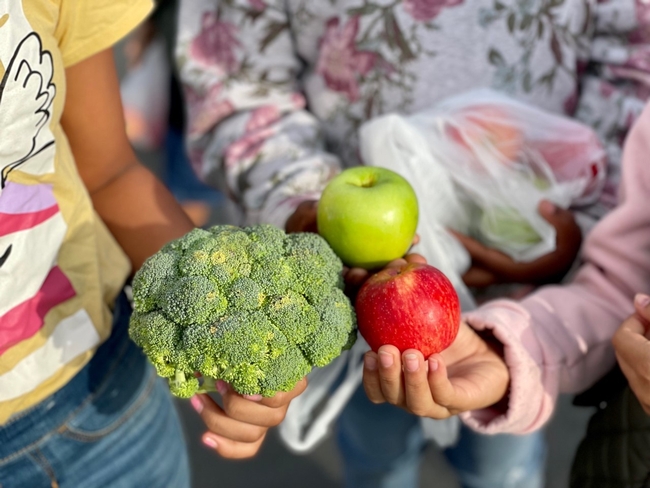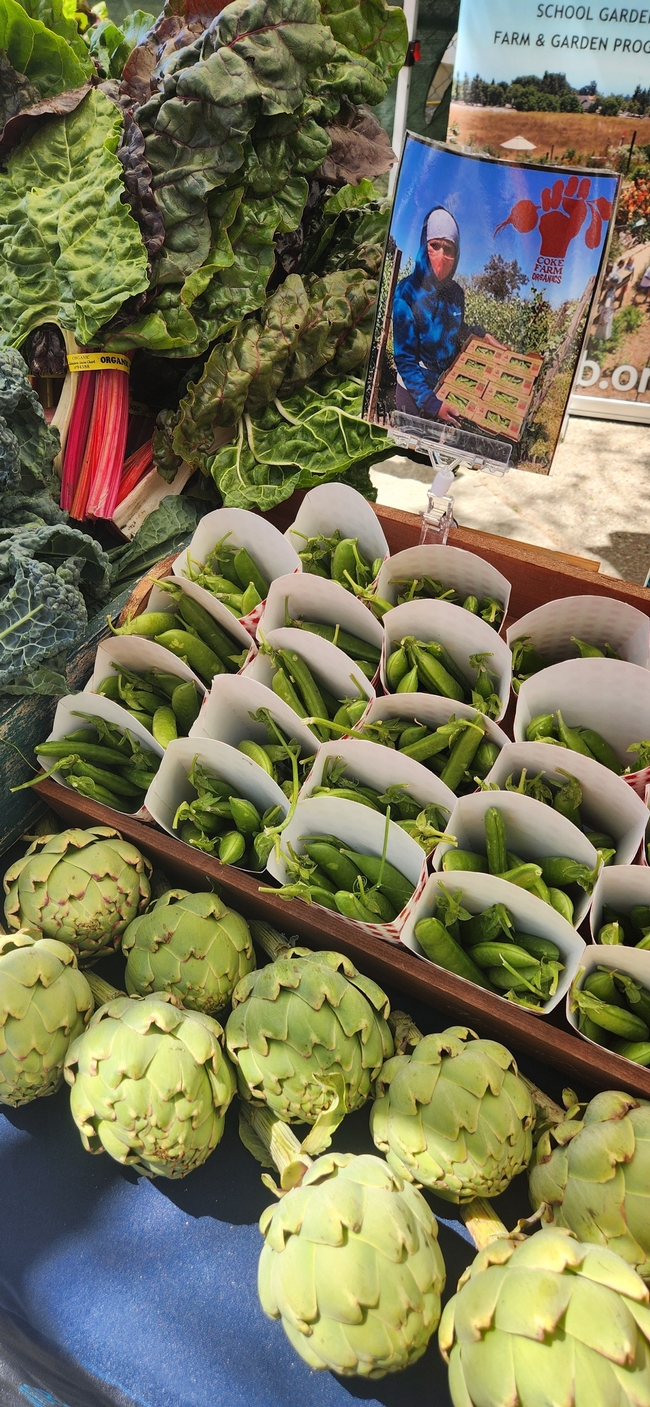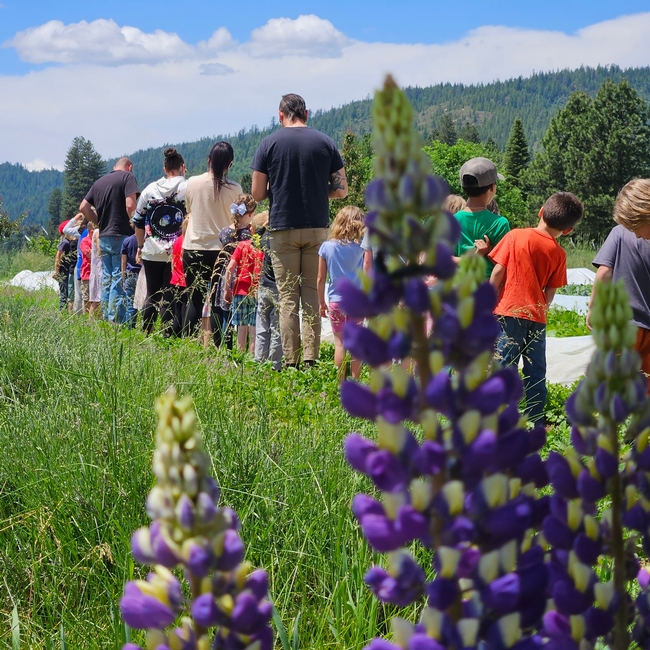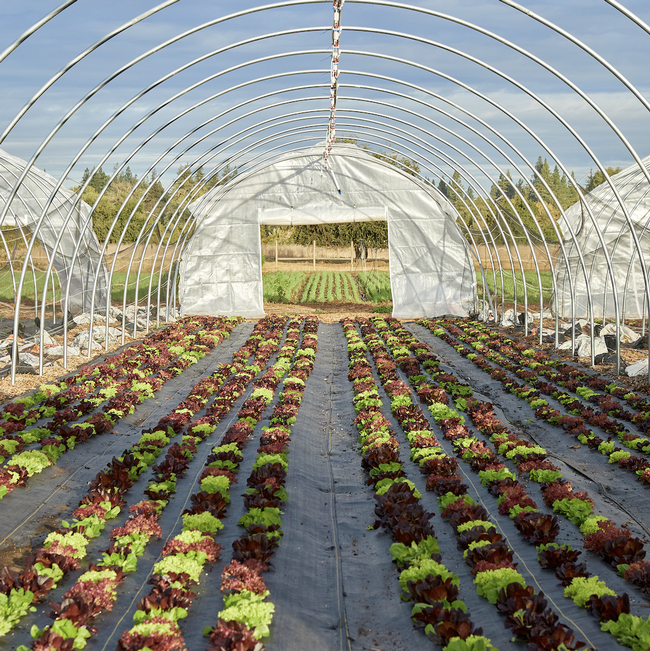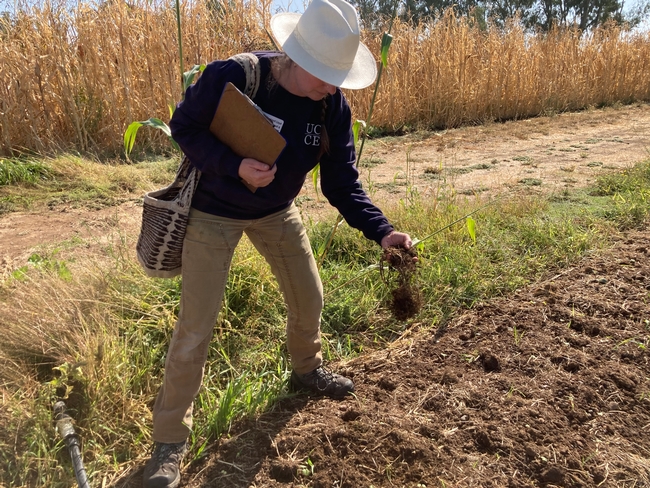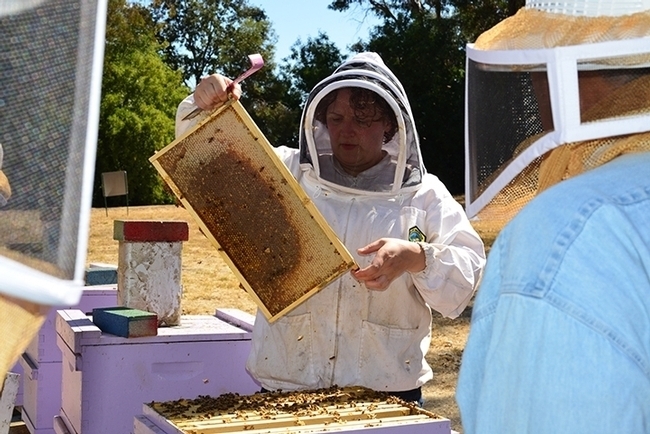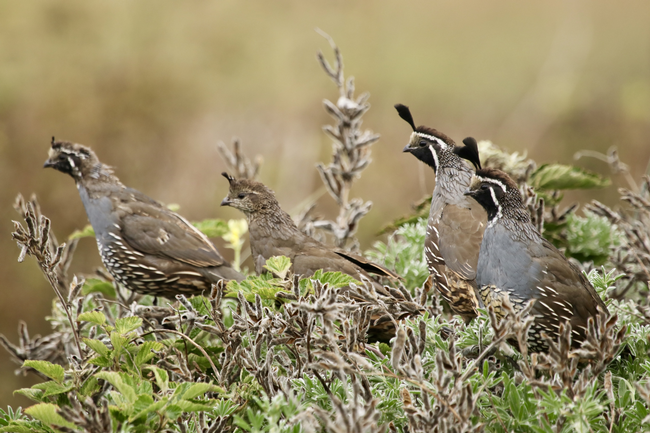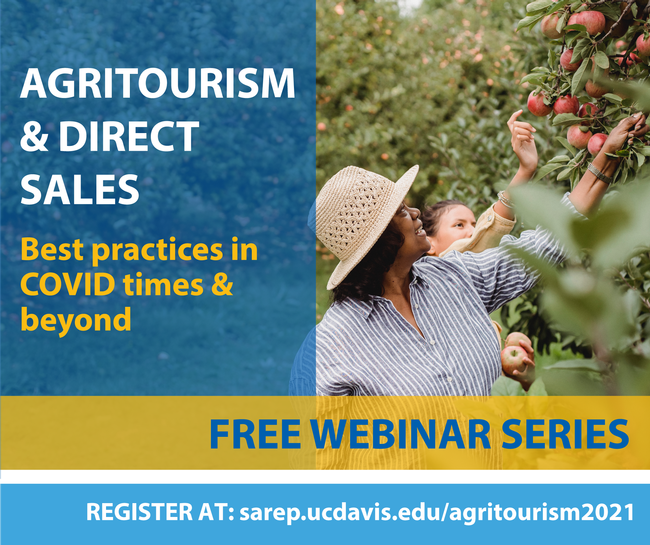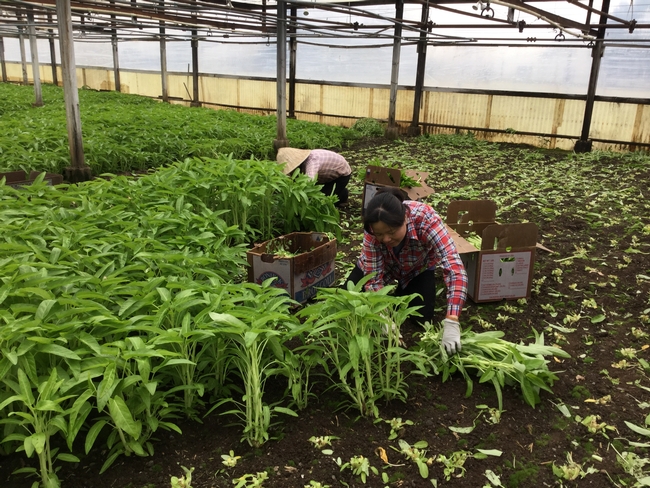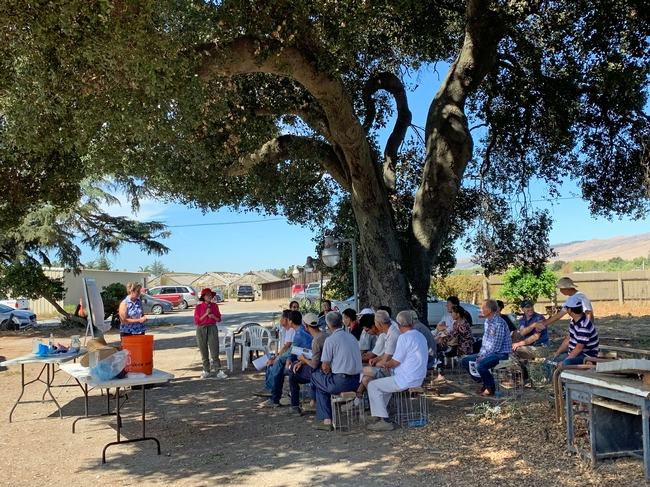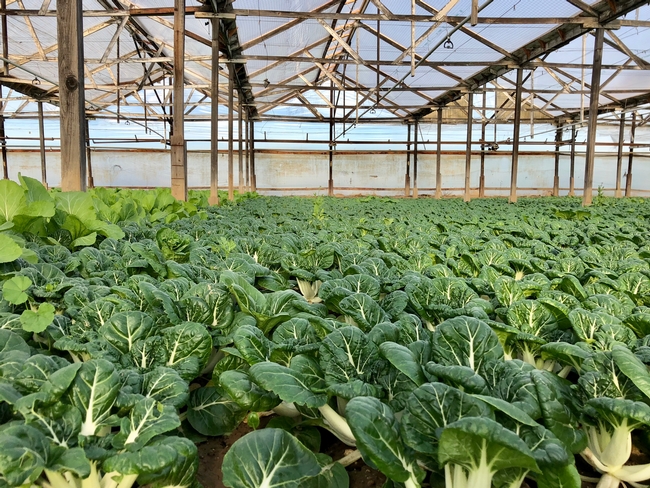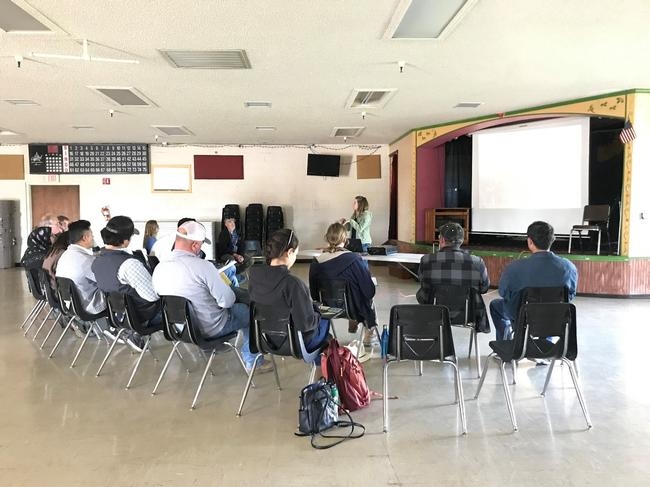Posts Tagged: farms
Investments in farm-to-school program stabilize farms, expand climate-friendly farming practices
Small and midsize farms, women and BIPOC farmers especially benefit
A new report reveals that California farmers participating in the state's Farm to School Incubator Grant Program are increasing sales of fresh, local and organic produce, meat and dairy products to schools, according to researchers evaluating program impacts. The report found that 57% of the program's farmers made sales to schools between April and September 2023, representing an average of 33% of their total farm revenues. All food producers funded by the Farm to School Grant Program state that they use or plan to use climate-smart agricultural practices in their operations during the grant period.
While existing research shows that kids who engage with farm-to-school programs eat more fruits and vegetables, are more willing to try healthy foods, and even perform better in class, the California farm-to-school evaluation project examines a gap that most farm-to-school research hasn't addressed: how local purchases from schools affect the agricultural sector and the environment.
The report found that the investments are flowing primarily to the farmers the state seeks to support through this program: Of the 50 producer grantees evaluated in this report, 42% are owned by people who identify as Black, Indigenous and People of Color, and 62% are owned by women. Nearly all (94%) are small to midsize operations.
Three producer grantees revealed that the Farm to School Incubator Grant Program funding likely prevented them from going out of business. “This grant … has and will enable us to do things on the farm that would probably take us a decade to do but we'll be able to do that in one or two seasons. So [it] really moves us forward a lot,” noted one farmer.
Beth Katz, a lead researcher and executive director of Food Insight Group, said, “Farmers are expanding their relationships with local school districts, increasing their sales to schools, investing in infrastructure and staff, and forming new relationships with food hubs that can help them with the often complex purchasing requirements unique to school food. While we're still at a very early stage of understanding the impacts of these investments, we're beginning to see patterns emerge.”
A Humboldt County farmer noted that food hubs, which are also supported by the grant program, are critical to their success in accessing the school food market: “[The food hub] is really a huge game changer to be able to make that one drop in town, even though it's an hour away, rather than going to [several school sites] and just making all these little drops. That's been one of the ways that it's very . . .appealing to us as a farm to participate.”
The report also examines the potential for environmental impacts through direct investments in farmers who use climate-friendly farming practices.
“I'm inspired by the potential for the farm-to-school program to support farmers using environmentally beneficial practices like reducing pesticides, planting cover crops and growing organic — and to help farmers expand or adopt these practices. It's essential these farmers have a market for what they grow to see durable environmental benefits,” said Tim Bowles, who is leading the environmental impacts assessment for the evaluation team and is an assistant professor in the Department of Environmental Science, Policy & Management at UC Berkeley and lead faculty director of the Berkeley Food Institute.
“We're also seeing farms actually expand their acreage in order to sell to schools, suggesting this is a desirable market. We're investigating the environmental impacts from these investments, especially for climate,” Bowles said.
As with many new programs aimed at building out long-delayed infrastructure, school food systems improvement demands a deep-rooted approach.
“The challenges around changing a complex school food system are substantial,” Gail Feenstra, a pioneer in farm-to-school research and co-lead on the project from UC ANR stated. “Decades of research shows the value to children from fresh, locally sourced food. However, what is becoming more clear from this research is that long-term investments in the full farm to school system are crucial. Without regional-level infrastructure, staffing, aggregation and distribution in place to support getting that locally grown food from farms to the schools and kids, we'll have challenges moving the needle.
"Fortunately, the state's strategic and innovative investments in the entire farm to school supply chain – meaning funding for school districts, farmers and also their regional partners, combined with support from CDFA's regional staff – are beginning to address those long-standing challenges.”
UC offers resources for urban farmers at EcoFarm
University of California scientists will be participating in the 44th Annual EcoFarm Conference Jan. 17-20 in Pacific Grove. EcoFarm participants gather to celebrate and learn about advances in farming and food systems throughout the state. This year, the three-day conference will highlight Black, Indigenous and People of Color communities that depend on agriculture, while also showcasing the new technological advances that further the development of agriculture.
Researchers from the UC Davis Veterinary Teaching Hospital's Department of Population Health, the Western Institute of Food Safety and Security and UC Agriculture and Natural Resources will be attending the conference to highlight the importance of food safety and technical skills in urban farming.
At EcoFarm, the Western Institute of Food Safety and Security will showcase its Civic Urban Farmer Program with an exhibit. The program, led by UC Davis assistant project scientist Sara Garcia and supported by UC Cooperative Extension, strives to uplift BIPOC communities.
The Civic Urban Farmer Program
The Civic Urban Farmer Program – a no-cost, 11-week program for farmers in the Sacramento region and Bay Area – provides technical support for new and upcoming urban farmers through webinars and in-person events. The program is available for any race, gender, age and skill ability, and seeks to provide safe, expert advice for farmers at any scale.
Soil health, composting, pest management, business marketing, food safety and urban policy are among the topics covered in its lecture-style classes.
Earlier this year, the program graduated its second cohort, with the support of two nonprofit organizations, Three Sisters Gardens in West Sacramento and Common Vision in Oakland. The program is supported by industry professionals, researchers and government officials, as well as local nonprofit and non-governmental organizations.
Elina Niño, UC Cooperative Extension specialist in apiculture, joined the Civic Urban Farmer Program to support urban farmers with training on managing pollinators to increase crop yields and create value-added products such as honey. The success of the pollinator program revealed that small urban farmers desire resources and education that are tailored specifically toward the cultivation of healthy and safe food.
For more information about the Civic Urban Farmer Program, visit https://www.wifss.ucdavis.edu/urbanfarmers.
Organic Agriculture Institute
The UC Organic Agriculture Institute, led by UC Cooperative Extension specialist Houston Wilson, will have an exhibit at EcoFarm. UC Organic Agriculture Institute brings together growers, certifiers, consultants, community groups and other stakeholders with UC research and extension personnel to share information about organic farming.
For more information about the UC Organic Agriculture Institute, visit https://organic.ucanr.edu.
Workshop speakers
Several UC Cooperative Extension advisors will be speaking at EcoFarm, including Richard Smith, UCCE emeritus vegetable crops advisor; Patricia Lazicki, UCCE vegetable crops advisor; and Margaret Lloyd, UCCE small farms advisor.
Connect with @ucanr on X, Instagram and LinkedIn.
Bringing out the best in wild birds on farms
Natural habitat maximizes the benefits of birds for farmers, food safety and conservation
A supportive environment can bring out the best in an individual — even for a bird.
After an E.coli outbreak in 2006 devastated the spinach industry, farmers were pressured to remove natural habitat to keep wildlife — and the foodborne pathogens they can sometimes carry — from visiting crops. A study published today from the University of California, Davis, shows that farms with surrounding natural habitat experience the most benefits from birds, including less crop damage and lower food-safety risks.
The study, published in the Journal of Applied Ecology, was conducted at 21 strawberry fields along California's Central Coast. It found that birds were more likely to carry pathogens and eat berries without surrounding natural habitat.
The authors said a better understanding of the interplay of farming practices, the landscape, and the roles birds play in ecosystems can help growers make the most out of wild birds near their fields.
“Bird communities respond to changes in the landscape,” said lead author Elissa Olimpi, a postdoctoral scholar in the UC Davis Department of Wildlife, Fish and Conservation Biology at the time of the study. “As birds shift in response to management, so do the costs and benefits they provide.”
The single most important driver
The study looked at how different farming practices influenced the costs and benefits that wild birds provided on the strawberry farms. The scientists combined nearly 300 bird surveys and the molecular analyses of more than 1,000 fecal samples from 55 bird species to determine which birds ate pests, beneficial insects and crops, and carried foodborne pathogens.
They also ranked birds to see which were more likely to bring benefits or costs to farmlands. Barn swallows, for instance, got a “gold star” in the study, Olimpi said. Their mud nests are commonly seen clinging to the underside of barn eaves, from which they fly out to swoop over fields, foraging on insects.
But rather than resulting in a list of “good” and “bad” birds, the study found that most bird species brought both costs and benefits to farms, depending on how the landscape was managed.
The presence of natural habitat was the single most important driver differentiating a farm where wild birds brought more benefits than harm.
“Nature is messy, and birds are complex,” Olimpi said. “The best we can do is understand how to take advantage of the benefits while reducing the harms. Growers will tell you it's impossible to keep birds off your farm — you can't do that and don't want to from a conservation perspective. So how can we take advantage of the services birds provide?”
Win-wins for birds and farms
The study is one of several publications from UC Davis Professor Daniel Karp's lab highlighting the environmental, agricultural, and food safety impacts of conserving bird habitat around farms. A related study in 2020 found that farms with natural habitat attracted more insect-eating birds — and fewer strawberry-eating birds — so that farmers experience less berry damage on farms with more habitat nearby. Such habitats also bring greater numbers of bird species to the landscape.
“All together, these studies suggest that farming landscapes with natural habitat tend to be good for conservation, farmers, and public health,” said Karp.
Additional co-authors of this study include Karina Garcia and David Gonthier of University of Kentucky, Claire Kremen of UC Berkeley and the University of British Columbia, William E. Snyder of University of Georgia, and Erin Wilson-Rankin of UC Riverside.
The research was funded by the USDA and UC Davis Department of Wildlife, Fish and Conservation Biology.
UC ANR offers free online trainings on direct sales and agritourism
The economic shocks brought on by the COVID-19 pandemic have pushed California's farmers and ranchers to quickly embrace new business practices — including creative new ways to sell directly to consumers. UC ANR and partners are offering an eight-part series of free virtual trainings to help producers build their businesses with agritourism and other direct-to-consumer sales.
The COVID-19 pandemic has been a huge shock to California's food economy, forcing many of the state's growers to embrace new business practices and drop old ones as “shelter-in-place” directives rolled across the state.
But the pandemic's challenges bring new opportunities too. Consumers' interest in local food and local outdoor experiences has grown immensely, from community-supported agriculture (CSA) and other online ordering, delivery and on-farm pickup options, to visits to farm stands, U-pick operations and other family-friendly socially distanced outdoor activities.
Pivoting to these new marketing channels opens new revenue opportunities for farmers and ranchers across California and the nation. But each new marketing channel also demands new skills and connections.
To help build growers' skills to embrace these market channels, the University of California Sustainable Agriculture Research and Education Program (UC SAREP) at UC Agriculture and Natural Resources is partnering with the Community Alliance of Family Farmers (CAFF) and expert growers across California to offer the free webinar series Agritourism and Direct Sales: Best practices in COVID times and beyond.
Through eight one-hour virtual trainings held this spring, participants will learn about best practices for implementing a variety of direct-to-consumer sales approaches. These trainings are offered to anyone interested in learning more about direct-to-consumer sales and agritourism. Topics and dates are:
| Getting started with community supported agriculture |
Tuesday February 23, 11am–12pm PST |
| Best practices for U-pick operations | Monday March 8, 3-4pm PST |
| Operating a safe, healthy and successful farm stand | Monday March 22, 3-4pm PST |
| Best practices for visitor interaction with animals | Monday April 5, 3-4pm PST |
| Best practices for farm tours, workshops and farm-based education | Monday April 19, 3-4pm PST |
| Online sales options and methods | Monday May 3, 3-4pm PST |
| Creative marketing and staying connected with social media | Monday May 17, 3-4pm PST |
| Community collaboration – farm trails, tourism partners and more | Monday May 24, 3-4pm PST |
Register at sarep.ucdavis.edu/agritourism2021.
For more information:
Penny Leff, UC SAREP, paleff@ucanr.edu, 530.902.9763 (cell)
Funding for this webinar series was made possible by the U.S. Department of Agriculture's (USDA) Agricultural Marketing Service through grant #AM200100XXXXG177. Its contents are solely the responsibility of the authors and do not necessarily represent the official views of the USDA.
UCCE small farms advisor strives to make farming more inclusive and equitable
This is one of a series of stories featuring a sampling of UC ANR academics whose work exemplifies the public value UC ANR brings to California.
The coronavirus pandemic has disrupted life for everyone, with information about COVID-19 changing daily. For Californians who aren't fluent in English, obtaining reliable information is particularly difficult. Aparna Gazula, a University of California Cooperative Extension advisor who serves Santa Clara, San Benito and Santa Cruz counties, has been providing COVID-19-related information in Chinese and Spanish for immigrant Bay Area farmers.
In March, when restaurants shut down to curb the spread of the virus, many restaurants and wholesale produce markets cancelled produce orders placed with farmers. Language, cultural differences, low computer literacy and limited access to computers created barriers for small-scale, immigrant farmers in the Bay Area to quickly find new buyers for their perishable produce. Gazula introduced them to food banks, hoping they would accept the produce donations, but the food banks were not set up to pick up donations from small farmers.
Most small-scale farmers lack the financial capital to absorb the revenue shock. To help offset losses from unsold specialty crops, the UCCE advisor and Qi Zhou, the small farm program assistant specialist, have been helping Asian and Latino farmers complete English-language disaster aid applications.
“Since March, we have helped farmers apply for Covid-19-related farmer relief funds,” Gazula said. So far, she said, four of the 17 immigrant farmers who applied to the American Farmland Trust Farmer Relief Fund have received a total of $4,000, and 10 farmers of the 30 who applied to the California Family Farmer Emergency Fund received a total of $42,500.
Recently the U.S. Department of Agriculture expanded the list of specialty crops eligible for its Coronavirus Food Assistance Program to include bok choy, daikon and other vegetables with a deadline of Sept. 11. Communicating by phone and the app We Chat, Gazula and Zhou, who speaks Mandarin, notified local farmers, and advised them how to apply for the disaster funds. Zhou, USDA Natural Resources Conservation Service rangeland management specialist Ling He and another NRCS staff member assisted 64 farmers in completing applications over the past week.
Bob Kuang, president of the Bay Area Chinese Growers Association, shares UCCE information with the association's growers.
“Most of my members don't understand English so they [UC Cooperative Extension] help, like for policy and safety,” Kuang said, "providing information the growers can't find elsewhere in Chinese.”
When she was a girl, Gazula saw how hard farmers work to make a living off the land while spending summers and winter breaks at her grandparents' farm in India, where they grew rice, mung beans and chili peppers.
“Farmers are very hardworking people, and small farmers even more so as they manage everything on the farm,” said the small farms and specialty crops advisor. “Their grit, determination to succeed and hardworking spirit truly inspire me.”
“I'd like to help them be successful as much as I can,” she said, “be it research-based information to farm successfully or bilingual support to help them better navigate regulations or apply for grant funds.”
In addition to helping farmers apply for financial relief, Gazula alerted the farmers to shelter in place rules and is delivering COVID-19 safety information about masks, sanitation and social distancing requirements in Chinese and Spanish to them.
“We also helped farmers implement COVID-19-related protocols on their farms,” she said. “We are currently putting together 200 COVID-19 kits that will help farmers comply with worker health and safety-related protocols on their farms. The COVID-19 kits contain reusable masks, hand sanitizer, bilingual Cal OSHA guidelines for employers regarding COVID-19, and a resources sheet listing where to buy the enclosed items.”
When she's not involved in COVID-19 crisis communications, Gazula continues to conduct research on nitrogen uptake in bok choy and bell peppers and irrigation management. She collaborates with Linda Chu, Guo Ping Yuan, Han Qiang Kuang and other Santa Clara County growers who allow the farm advisor to study crops on their farms.
“They do research, like test irrigation systems for right amount of water for the crop and nutrition – fertilizer – for the crop. They do lot of things,” said Kuang, of the Bay Area Chinese Growers Association, who provides land at his farm in Gilroy for UCCE studies.
Gazula also advises farmers on how to implement the Food Safety Modernization Act (FSMA) on their farms and fulfill irrigated land nitrogen reporting. Fines for not complying with regulations can threaten the economic sustainability of small family farms.
Although the majority of growers she works with regularly have limited English and need assistance filing reports to the government, others consult her for production information they can't get elsewhere for the specialty crops they grow. Farmers of Korean, Japanese, Indian and Vietnamese ancestry and others attend meetings to learn the latest research on Asian vegetables such as daikon radish, napa cabbage, bok choy, on choy and various Asian leafy mustard crops including gai choy and pea shoots.
Gazula, who joined UC Cooperative Extension in 2016, currently works with about 180 small-scale growers in San Benito and Santa Clara counties and hopes to expand her outreach to farmers in Santa Cruz County.
To help small farmers adapt to climate change, Gazula and Zhou partnered with UC Agriculture and Natural Resources' Healthy Soils Program staff and Santa Clara County Farm Bureau for technical assistance and held workshops during the winter. Zhou helped the farmers apply for grants from the California Department of Food and Agriculture's State Water Efficiency & Enhancement Program and Healthy Soils Program. The 22 farmers who received CDFA grants brought a total of $424,111 into Santa Clara County.
The outreach work UC Cooperative Extension does wouldn't be possible without the help of bilingual staff such as Zhou, the scientist Gazula hired with grant funds in September, and some translation support from partner organizations and growers as well.
“Relying on partners for translation support isn't practical,” Gazula explained. “Outreach is most effective when it is targeted. It's not just literally translating words, but translating the information the words convey. Because we provide outreach materials to comply with regulations, the language in these materials is very technical and it's important that the information is presented accurately. We also depend on relationships with the farmers to extend the information within their communities. Long-term, it's easier to do outreach with support from our own staff.”
Competition is stiff for money to serve non-English-speaking Californians because the state is home to so many immigrants with different needs. The majority of the grants she uses for outreach are for food safety. The local Open Space Authority, which promotes preserving land for open spaces, has also provided funds for small and beginning farmer outreach and education.
Gazula draws on the expertise of fellow UC Cooperative Extension farm advisors across the state. For example, she said, Richard Smith, who specializes in vegetable production, and Michael Cahn, who specializes in irrigation and water resources, are always willing to help, even though they are not assigned to serve Santa Clara County.
“Farmers already have tremendous challenges when it comes to being successful,” Gazula said. “I feel language barriers and lack of access to the same resources as fluent English-speaking growers shouldn't be the reason they can't farm successfully.”

